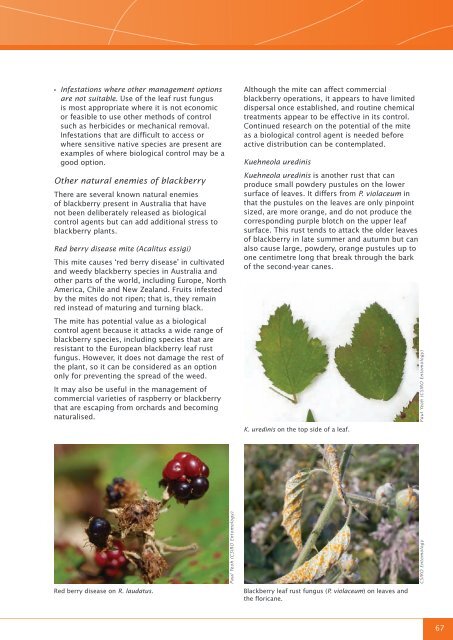Blackberry control manual - Weeds Australia
Blackberry control manual - Weeds Australia
Blackberry control manual - Weeds Australia
Create successful ePaper yourself
Turn your PDF publications into a flip-book with our unique Google optimized e-Paper software.
• Infestations where other management options<br />
are not suitable. Use of the leaf rust fungus<br />
is most appropriate where it is not economic<br />
or feasible to use other methods of <strong>control</strong><br />
such as herbicides or mechanical removal.<br />
Infestations that are difficult to access or<br />
where sensitive native species are present are<br />
examples of where biological <strong>control</strong> may be a<br />
good option.<br />
Other natural enemies of blackberry<br />
There are several known natural enemies<br />
of blackberry present in <strong>Australia</strong> that have<br />
not been deliberately released as biological<br />
<strong>control</strong> agents but can add additional stress to<br />
blackberry plants.<br />
Red berry disease mite (Acalitus essigi)<br />
This mite causes ‘red berry disease’ in cultivated<br />
and weedy blackberry species in <strong>Australia</strong> and<br />
other parts of the world, including Europe, North<br />
America, Chile and New Zealand. Fruits infested<br />
by the mites do not ripen; that is, they remain<br />
red instead of maturing and turning black.<br />
The mite has potential value as a biological<br />
<strong>control</strong> agent because it attacks a wide range of<br />
blackberry species, including species that are<br />
resistant to the European blackberry leaf rust<br />
fungus. However, it does not damage the rest of<br />
the plant, so it can be considered as an option<br />
only for preventing the spread of the weed.<br />
It may also be useful in the management of<br />
commercial varieties of raspberry or blackberry<br />
that are escaping from orchards and becoming<br />
naturalised.<br />
Although the mite can affect commercial<br />
blackberry operations, it appears to have limited<br />
dispersal once established, and routine chemical<br />
treatments appear to be effective in its <strong>control</strong>.<br />
Continued research on the potential of the mite<br />
as a biological <strong>control</strong> agent is needed before<br />
active distribution can be contemplated.<br />
Kuehneola uredinis<br />
Kuehneola uredinis is another rust that can<br />
produce small powdery pustules on the lower<br />
surface of leaves. It differs from P. violaceum in<br />
that the pustules on the leaves are only pinpoint<br />
sized, are more orange, and do not produce the<br />
corresponding purple blotch on the upper leaf<br />
surface. This rust tends to attack the older leaves<br />
of blackberry in late summer and autumn but can<br />
also cause large, powdery, orange pustules up to<br />
one centimetre long that break through the bark<br />
of the second-year canes.<br />
K. uredinis on the top side of a leaf.<br />
Paul Yeoh (CSIRO Entomology)<br />
CSIRO Entomology<br />
Paul Yeoh (CSIRO Entomology)<br />
Red berry disease on R. laudatus.<br />
<strong>Blackberry</strong> leaf rust fungus (P. violaceum) on leaves and<br />
the floricane.<br />
67

















